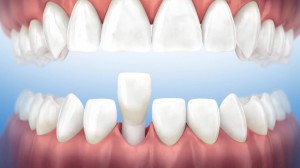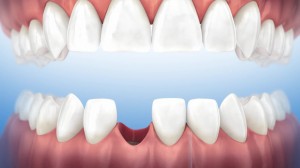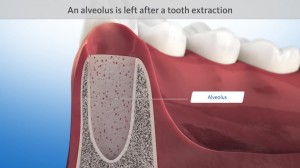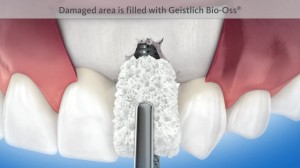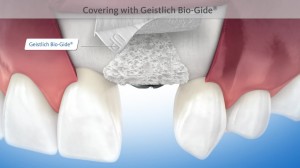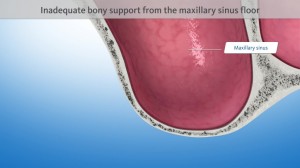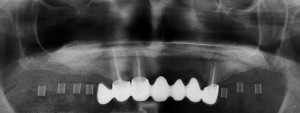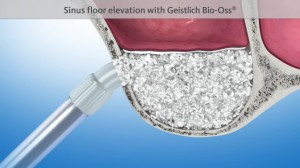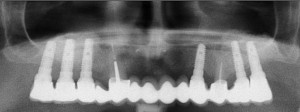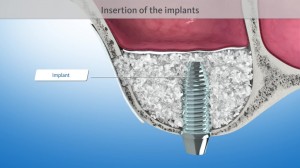1. Simple and surgical removal of teeth
Most teeth can be removed using a simple instrument. However, deep roots and impacted teeth require a minor surgical intervention. These small operations are called exploratory tooth removal. We do the intervention with local anaesthesia. We make a cut on the gum to access the tooth, remove it and close the wound with stitches. With proper aftercare at home, cooling of the surgical site and following your dentist’s instruction you can make your recovery less unpleasant. See What to do after tooth removal?
Surgical removal of wisdom teeth: Removal of an impacted wisdom tooth may require detachment of the gum covering the tooth and removal of the bone around it. If it is possible we fragment the tooth inside the bone. A fragmented wisdom tooth occupies a smaller place in the bone, therefore we have to remove less of your own bone. After the extraction we clean the wound and remove bone or tooth fragments and the remains of the root sheath. If there is a cyst around the tooth, we remove it as well. Then we disinfect the wound, close it with loose stitches and drain the discharge. For instructions on how to take care of the wound see What to do after surgical interventions?
2. Alveolar socket preservation
Alveolar socket preservation is a procedure to treat the extraction site immediately after tooth removal. The alveolar socket is a crater in the gum left by the extracted tooth. It takes weeks or months for your body to restore the gum. After tooth extraction the so called fasicular bone is absorbed and the tissues shrink. In the aesthetic zone of the mouth or in areas where we would like to place implants, this process can have an adverse effect on the outcome. We can prevent it. We can preserve the alveolar socket by replacing the bone and the connective tissue immediately after the extraction. Thus healing will lead to minimal loss of bone. There are several types of alveolar socket preservation. With these techniques we can prevent bone loss and the mobility of the neighbouring teeth. We can also restore the supporting structure of the tooth.
The following illustrations show a case when tooth extraction results in an unstable condition which affects the neighbouring teeth unfavourably.
With alveolar socket reservation we can restore the site of the extraction and strengthen the position of the neighbouring teeth.
3. Bone augmentation
Bone augmentation is indicated if bone mass around the site of the extraction is reduced, and the jaw is thin and unsuitable for implants. There have been significant advances in bone augmentation, many techniques and bone substitutes are available. Depending on the type of the defect in the bone, we can use your own bone, or a mixture of synthetic bone substitutes and membranes. At Dentoplant Clinic we use high quality materials and membranes which have undergone extensive clinical testing. The intervention is performed with local anaesthesia. If a major surgical intervention is considered, you can consult our anaesthesiologist about further types of anaesthesia and sedation. See Patient information on anaesthesia.
What are the indications for bone augmentation?
- Alveolar socket preservation after extraction
- Minor bone augmentation for implants
- Major bone augmentation in thin jaw bones if tooth loss has resulted in wasting of the bone
- Sinus augmentation
- After periodontal treatment to induce regeneration of tissue around the teeth
Minor bone augmentation for an implant:
Bone augmentation around teeth: This oral surgical intervention, known as periodontal regeneration, is a special field of periodontal treatment. Given certain criteria, we can rebuild the tissues around the teeth applying various regenerative materials or a combination of materials. See Treatment of periodontal diseases.
4. Sinus augmentation
Sinus augmentation is a procedure to increase the thickness of the floor of the sinus (the cavity in your face). In many patients the floor of the sinus is too thin to receive an implant. It is partly due to certain anatomical conditions (such as a large sinus or roots of teeth penetrating into the sinus) or to the wasting of the upper jaw as a result of previous extractions.
Depending on the extent of bone loss, there is closed and open augmentation.
- Closed sinus augmentation involves inserting a special bone substitute (Summers sinus lift series) into the sinus through the opening in the bone prepared for the implant.
- Open sinus augmentation is performed with local anaesthesia. First, we make a flap and open a window on the side wall of the sinus. Then we separate and raise the mucous membrane of the sinus, and fill the space with bone substitute. Finally, we close the window and fix the gum with stitches. See What to do after sinus augmentation?
1. Initial X-ray before sinus augmentation. The patient has missing molars on each side, and implantation is only possible after bone augmentation. There is wasting of the jaw bone which has resulted in insufficient bone mass to support an implant. Therefore sinus elevation with bone augmentation is required. The healing time is 6-9 months.
2. The X-ray shows increased bone mass after sinus elevation with bone augmentation. Cbct measurements have confirmed sufficient bone mass for an implant.
3. Implants with the bridge. This restoration could not have been done without sinus augmentation.
5. Vestibuloplasty
What are the common indications for vestibular correction?
- Pre-prosthetic (before fabricating the dental prosthesis) intervention, when the patient cannot wear the removable denture because the vestibulum is too shallow. We cannot extend the plate of the denture to be retained in the mouth. Usually it is enough to correct a small bunch of muscle that prevents proper fitting.
- Around implants in order to restore and widen the attached gingiva. If the gum around the implant-based bridge is not tight enough, the pumping pressure of chewing forces plaque and food particles into the gap between the tooth and the gum leading to inflammation. We can prevent it by making the gum tight around the tooth.
- After major bone augmentation to increase reduced depth occurring owing to the stretching of bigger flaps.
- After surgical reconstruction of gingival recession to tighten the gum, or in the presence of high attached frenulum.
6. Tooth preservation surgery
The aim of tooth preservation surgery is to stabilise teeth which are at risk for various reasons, so that they can be retained in the mouth. In the past tooth preservation surgery mainly involved apical root resection (cutting off the tip of the root). Thanks to the advances in root canal therapy, this intervention is less common. Recently, more effort is made to restore the bone around teeth affected by periodontal disease that can be spared according to your dentist.
- Apical root resection
The intervention involves surgical removal of inflamed tissue at the tip of the root. It is performed if the tooth is dead or has undergone root canal treatment and there is an inflammation or a cyst around the tip of the root, if an inflammatory disease is suspected, or if the circumstances revealed during endodontic treatment make it necessary. The intervention is performed with local anaesthesia. We make a small cut, remove the infected segment of the root tip, clean and disinfect the area, and close the wound.
- Bone augmentation around teeth
This oral surgical intervention, known as periodontal regeneration, is a special field of periodontal treatment. Bone augmentation is not a single intervention, it is part of a complex periodontal treatment. We also perform bone augmentation in patients referred to our clinic by other dentists. There are several types of bone augmentation. We decide what type of treatment is best for you after careful evaluation and consideration.
Common types of tooth preservation surgery include:
- strengthening of the periodontal structures with Emdogain®
- bone augmentation around the teeth to substitute bone sockets
- bone augmentation to compensate bone loss in the furcation of molar teeth
- techniques combined with connective tissue flap. See Periodontal treatments.



